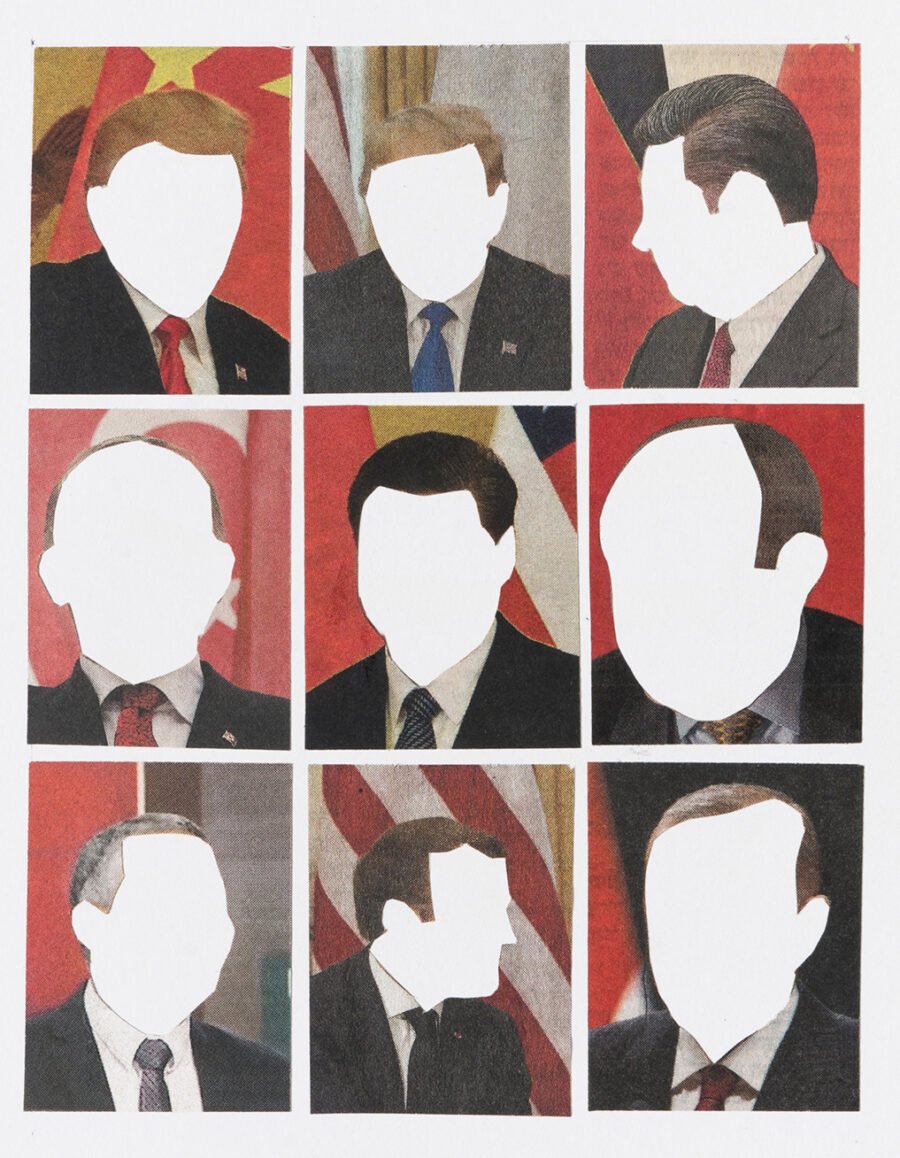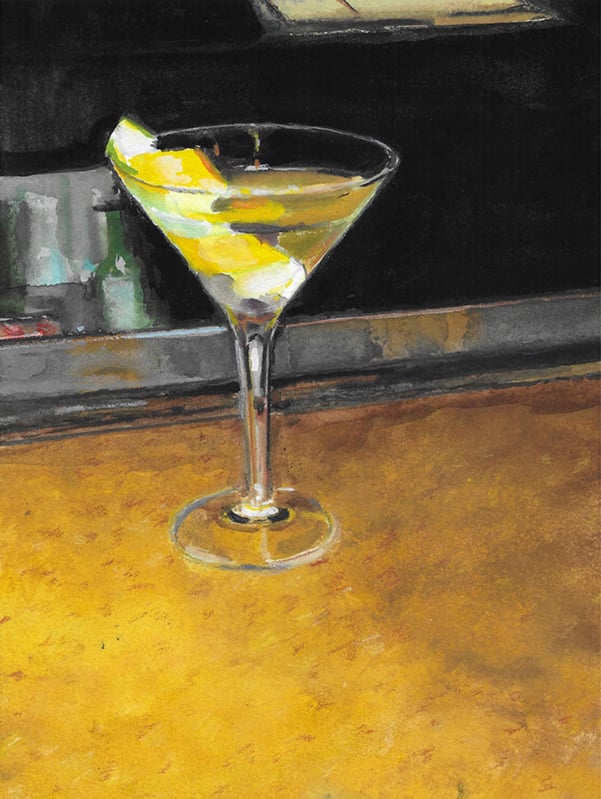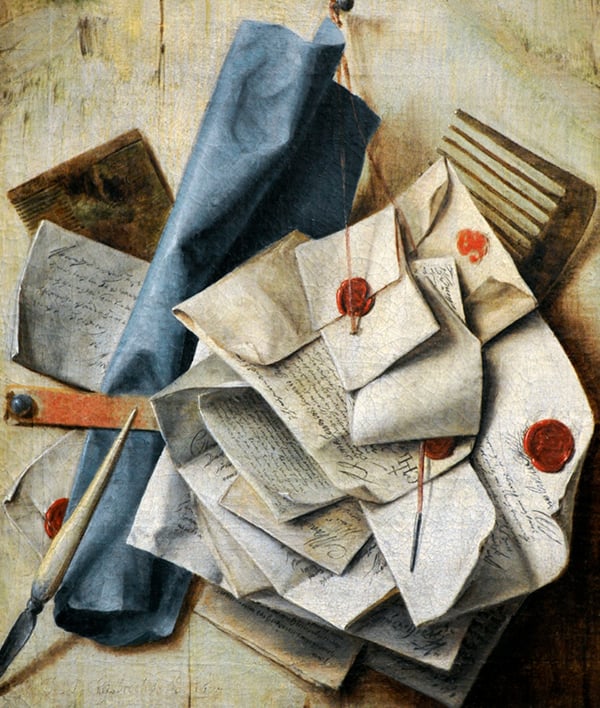
A collage by Liat Elbling, from the series Men in Suits © The artist
New Books
No one can torch the English language like a Beltway insider. A few years ago, phrases like “a feature, not a bug” and “saying the quiet part out loud” burned so fiercely through the Washington commentariat that they enjoyed hardly a moment between the flame of novelty and the ash of cliché. “Flood the zone”—used recently by the South Carolina congressman Jim Clyburn and the Clinton crony Philippe Reines, plus reporters at Politico, the Washington Post, and Axios—came into fashion in 2018, after Steve Bannon said, “The real opposition is the media. And the way to deal with them is to flood the zone with shit.” What zone? Whose shit? Not important. The expression, which comes from football, has such an intimidating, postmodern vagueness that pundits adopted it even after Bannon used it at their expense.
Phil Elwood is a professional zone flooder. He admits as much in the first chapter of All the Worst Humans: How I Made News for Dictators, Tycoons, and Politicians (Henry Holt, $28.99), a memoir of his years as a flack: “My strategy has been to flood the zone.” And yet, a few pages later, describing the first time he created “a false narrative,” he muddles the metaphor. He was twelve, and his father, a minister, was presiding over an open grave when it began to fill with a worrisome brown liquid, setting the casket afloat. Watching “shit-colored water swirl,” Elwood had his dad distract the congregation while he leaped into the earth to hold the coffin down. Ever since, he’s thought of himself as a casket sinker, though he could just as easily be the ugly tide.
And his tide has brought some bodies in. His client list is a veritable rogues’ gallery: the Qaddafis, Russia Today, the flashy file-uploading tech entrepreneur Kim Dotcom, the Nigerian government, a consortium of private-jet owners. Others, such as the U.S. Tuna Foundation, appear innocuous until you learn that, on the foundation’s behalf, he tried to persuade pregnant women to eat more canned fish, mercury poisoning be damned. His MO is to defend the indefensible and to get the media’s standard-bearers to do the same. This requires a proprietary blend of Rolodex flipping, “What if I were to tell you . . . ” phone calls, and spoon-feeding leads to reporters at happy hours, where he does his best work. “The public reads their stories and believes them because they are coming from a trusted news source and not a corporate bagman,” he writes.
Elwood possesses a genius for the inane. Like Tony Curtis’s sweating, fretting, sinning press agent in Sweet Smell of Success, he’s “a man of forty faces . . . all deceptive.” To help Qatar secure World Cup hosting rights over the United States, Elwood says he leveraged America’s childhood-obesity epidemic. His angle:
The United States’ failure to fully fund K-through-twelve physical-education programs while instead lobbying to host international sports events is harmful to the welfare of our nation’s children.
He paid a lobbyist ten grand to have his “resolution” slipped to a congresswoman from Detroit, who dutifully circulated it on the Hill; he then leaked the story to Politico, and before long, his cockamamie idea was news. It would be a stretch to say that this won the hosting privileges for Qatar—their cash bribes to FIFA officials probably had more to do with that—but it’s a stout piece of business all the same. Elwood’s boss Peter Brown dubbed him an “operative,” a term Elwood wants engraved on his tombstone. “We can’t just do a good job,” Brown once told Elwood. “We have to appear to do a good job.”

Untitled, by Dike Blair © The artist. Courtesy the artist and Karma
That’s a tall order when your job is to babysit Mutassim Qaddafi—the dictator’s fourth son, who insisted Elwood call him “The Doctor”—on a lost weekend in Vegas. “You’re definitely not supposed to spend Ramadan banging your infidel girlfriend and then heading to the pool for a noon cocktail,” Elwood writes, but that’s what The Doctor ordered. His suite reeked of “mall cologne and chain-smoked Marlboros.” He wanted to ship a Harley to Libya and buy jorts at the Gap. He saw Cirque du Soleil and Cher and was unmoved by both. His chief pleasure came from berating casino employees. The whole episode scarred Elwood. Something about the Qaddafi retinue’s lust for guns, coke, and motorcades made him question his life choices. Brown fired him (“The Arab Spring has been bad for our business model”), but even with a therapist and a Xanax scrip, he couldn’t resist the allure of the abhorrent. He later signed on with Psy-Group, an Israeli intelligence firm whose promotional materials argued that reality “is a matter of perception.” The agency asked him to keep a laptop running in a locked drawer at all times and to move money through his personal bank account for them—job responsibilities that brought the FBI to his door.
His book is suspended precariously between apology and celebration. It’s terrific fun, but there’s something unresolved in the dishy mea culpa tone. Elwood positions himself as an adrenaline junkie who chased a few too many thrills by, say, kowtowing to “people who blew up Pan Am Flight 103 and murdered their own citizens with sarin gas.” He grew so disgusted with his various complicities that he attempted suicide. By the final page, though, he’s returned to the PR industry, relishing his role as “resident arsonist.” This time, he swears his fiery perfidy will help “the good guys.” We’ll have to take his word for it, as he doesn’t tell us who his new client is, only that “each face” on their video calls “earns a salary north of a million dollars.”
Because Elwood says little about his political philosophy—what role, for him, would a PR firm serve in the best of all possible worlds?—his sense of good and evil is oddly superficial; he’s one of those grown men who’s really into Star Wars, where the baddies tend to be in uniform. I, too, would yearn to escape to a galaxy far, far away if I made my home in Washington, but for him it’s the only place: a town of tacky steak houses, patio bars, and seersucker sport coats by Jos. A. Bank. He wishes the rest of us would go easy on it. “After twenty years in this city, I have met so many people who want to make the world a better place,” he writes. He doesn’t introduce us to any of them, though he could still call the book All the Worst Humans if he did.
In 1911, the National Poultry, Butter, and Egg Association launched a public-relations long shot of Elwoodian proportions: they got more than four hundred people to ingest refrigerated food in public. Convened at the banquet hall of a tony Chicago hotel, these intrepid souls sat “in a flutter of expectation at the prospect of eating, for the first time in their lives, a dinner where every item on the bill of fare had been in cold storage,” a reporter wrote. The chicken they ate had been slaughtered around Valentine’s Day; it was now nearly Halloween. But everyone survived, and not a single intestine was heard to cry foul.
In Frostbite: How Refrigeration Changed Our Food, Our Planet, and Ourselves (Penguin Press, $30), Nicola Twilley writes of the technology’s turbulent ascent from ungodly curiosity to ubiquitous necessity. What the French called frigoriphobie was a natural response to the “zombie foods” that now emerged from an artificial winter in “a disquieting suspension of organic matter’s inevitable destiny.” Food was supposed to rot. Freshness, like life, meant nothing if it was prolonged indefinitely. In a London municipal meeting, it was said to be “against public morals to do anything which would prevent the getting rid of perishable meat as quickly as possible.” A Buffalo newspaper put the finest point on it: there is no death, only cold storage.
In fact, early cold storage offered plenty of death. Food poisoning was endemic, but sometimes the fridges also just blew up. At the Chicago World’s Fair of 1893, a warehouse able to cool thousands of pounds of food that had been dubbed the “Greatest Refrigerator on Earth” burst into flames, killing more than a dozen people. Even when the fridge wasn’t lethal, it carried a flavor of the end, as in the case of a “young Irish fellow” who, upon trying ice cream for the first time, shouted, “Jasus! I am kilt. The coald shivers is on to me.”
On top of the shivers, fires, and plagues, fridge innovators had to contend with the basic headache of moving cold stuff in a hot world. One purveyor of frozen meat outlined the problem: “Where the food is, the people are not; and where the people are, the food is not.” In 1805, Frederic Tudor, later known as Boston’s Ice King, seized on the notion of harvesting winter itself, developing a system of icehouses around New England’s lakes and eventually shipping large ice blocks by boat. The business drove him into debt and to the brink of insanity. “The idea was considered so utterly absurd by the sober-minded merchants as to be the vagary of a disordered brain,” his brother-in-law recalled, while Tudor, in his journal, entreated himself to “sell out in the best way you can and become a regular man.”

A photograph by Gordon Parks, 1943. Courtesy the Library of Congress
But the King died rich, because people wanted ice. The cold chain represents man’s ungainly triumph over space and season. Twilley dismantles it link by link: refrigerated trucks, railcars, planes; the development of fridge-friendly fruits, lettuces, cheeses; the rise of orange-juice speculators and businessmen who say things like “you take Mother Nature and standardize it.” There’s the Anthropocene in a nutshell. I kept expecting to get bored, but I didn’t, even though Twilley spends a lot of time in frigid, depopulated, windowless rooms; repurposed mines and caves; and automated storehouses tucked off the interstate—all that precedes the comforting glow of the freezer aisle. Her writing shimmers on the far side of the consumer moon, among chasms of yogurt and “vast, anonymous cuboids filled with millions of apples hibernating in the dark.” In an Americold warehouse, she watches as “the aseasonal fulfillment of American desires continued unabated”:
Frozen guava juice in barrels, destined for a Dr. Smoothie bottling plant; cans of refrigerated peanut butter paste, imported from Argentina to fill M&M’s and Clif Bars; pallets stacked with rolls of X-ray film for local hospitals; and thousands and thousands of freshly baked King’s Hawaiian buns, trucked in hot from Torrance. . . . I couldn’t help but feel like a cog of cold-stiffened flesh in a perpetual protein-shuffling machine. Box after box of Asian white shrimp and imitation crab meat was stacked forty feet high to the ceiling. One pallet held gallons of beef blood in milk cartons; the label on another set of boxes said that they contained bull pizzles, hearts, and livers. “We call that ‘misc.,’ ” said Cesar.
The cold chain now binds nearly every corner of the earth, but Twilley, born in Britain, is right to see it as an American fixation. We love our misc., and we want it served chilled. An Englishwoman visiting New York in the 1840s found herself pleasantly overwhelmed by frosty beverages and cool cobblers. “Whenever you hear America abused,” her hostess told her, “remember the ice.”
Giambattista della Porta, the Renaissance natural philosopher, found that salting ice lowered its melting point, a discovery through which he bequeathed to us gelato and wine slushies. For different reasons, his work looms in the background of Spycraft: Tricks and Tools of the Dangerous Trade from Elizabeth I to the Restoration (Yale University Press, $30), a diverting history and how-to manual from Nadine Akkerman and Pete Langman, who write of the indelible mark della Porta left on the practice of espionage. He developed a suite of cryptographic techniques that proliferated in English epistolary life during the sixteenth and seventeenth centuries, when important people desperately wanted to send letters without recourse to invisible ink or an impenetrable code. As Ben Jonson, supposedly himself a spy, wrote in an early seventeenth-century epigram,
They all get Porta for the sundry ways
To write in cipher, and the several keys
To ope the character. They’ve found the sleight
With juice of lemons, onions, piss, to write
To break up seals and close ’em.
English spies were as contemptible at the time as PR professionals are today, and not nearly as inventive—they stole most of their tradecraft from the Continent, where Spaniards and Italians like della Porta had far outpaced them. England’s isolation, geographically and religiously, meant that it was “a hotbed of conspiracy,” Akkerman and Langman write, “riddled with Jesuits.” Catholics aspired “to return this upstart island to the one true faith.” In short, treason and deceit were thick on the ground, despite their severe consequences. Counterfeiters could be punished by having their ears cut off and their nostrils slit; even those who retained their services referred to them as pygmies and toads. All this meddling changed the face of correspondence. One might have to spend all night beside a stinking tallow candle decrypting sentences that read like Gmail passwords: “I have had newes from K. 50. 6nfzn. 4kmyhq4. 4lmp. 5mnw last 4dkwzhu.”

Quodlibet, 1675, by Cornelis Norbertus Gijsbrechts © Tarker/Bridgeman Images
Unfortunately, to crack such messages, a spy needed only to get a copy of the cipher wheel, and that was as easy to intercept as anything else in the mail. With cleverness or desperation, people hid notes in pig bladders, bullets, eggs, open wounds, fancy hairdos, wooden legs, and live dogs (“when he is killed, the letters may be found in his belly”). Oxford anti-royalists exchanged missives in a certain postbox made inconspicuous by the fact that men often stopped to pee near it. Those skilled in handiwork turned to letter locking—folding, threading, and weaving the paper such that it couldn’t be opened without betraying the tampering.
As always seems to be the case with intelligence work, no one quite knew what they were doing, and many innocents died along the way. The English had a fondness for poison, but, Akkerman and Langman write, their understanding of it was “caught in the twilight zone between magic, tradition and what we now call science.” We’re still mired there, in Bannon’s zone, vast and sodden. Reading Spycraft’s many accounts of meddling and manipulation, I thought back to the epigraph for Elwood’s book: “The single biggest problem in communication is the illusion that it has taken place.” He credits these words to George Bernard Shaw, and they’ve circulated for years among business-school types with this attribution, but Shaw seems never to have said such a thing. It was William H. Whyte Jr., the sociologist who coined the term groupthink.





